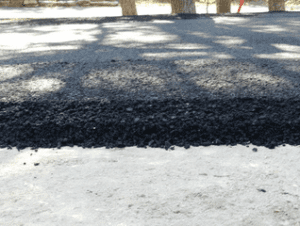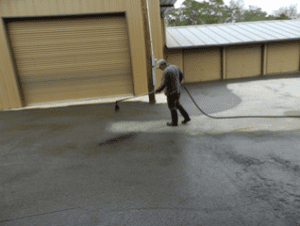ASPHALT PAVING

When heated to roughly 300 degrees, the liquid asphalt becomes liquid which allows for the aggregate and the liquid asphalt to be combined and mixed. This process is performed at an asphalt plant. The resulting asphalt is loaded into trucks for transport to the paving site.
The trucks dump the asphalt into the hopper located on the front of the paving machine. The asphalt is placed by the paving machine, and then compacted using a heavy roller, which is driven over the asphalt. Paving and compaction must be performed while the asphalt is sufficiently hot. Traffic is generally permitted on the asphalt as soon as the asphalt has cooled.
SEAL COATING

Seal coating is a mixture of oil, water, and slate. When applied, the water evaporates leaving the oil and slate as the new wear surface.
When covered with a dark black sealant, pavement looks and wears like new. Seal coating projects a positive image of the company, facility, or residential complex
Patching
Remove and Replace Patching
Areas that have significant cracking and/or uneven surface due to sub grade failure must be removed and replaced to keep the effected area from spreading. This method of repair is the most permanent, aesthetically pleasing type of patching, but it can be more expensive. The failed asphalt area will be sawcut and existing asphalt removed. Road base will re-compacted (added if needed) and a tack coat applied to the asphalt edge for bonding. New asphalt will be placed and compacted.
Crack Sealing
As the seasons change, asphalt expands and contracts. This movement causes cracks. If cracks are not sealed, they will allow water to flow through the asphalt to the base. The base will become saturated and will not be able to support the asphalt above. More crack will form allowing more water to enter the base. Without maintenance, this cycle will destroy your asphalt. Crack seal seals cracks from water. Crack seal is made of rubberized asphalt which expands and contracts with the crack. Crack sealing is one of the most important things you can do to extend the life of your asphalt.
Concrete
A concrete contractor can be a beneficial asset to any construction project, but there are certain steps that should be taken to ensure you will hire someone who will do a good job for you.
Most of the time, you can obtain information on a concrete contractor by asking questions at various businesses, such as home improvement stores, apartment complexes and flooring stores.
Skin Patching
Skin patching attempts to bridge over defects by adding a thin layer of compacted asphalt to the problem area. This application is typically used to repair potholes and settled areas around manholes or catch basins. It is considered a
temporary (1-3 year), inexpensive fix. Skin patches will alter the smoothness of your asphalt. The failed asphalt area will be cleaned of all loose debris. A tack coat will be applied to the existing asphalt for bonding. New asphalt will be placed and compacted.
Striping
A parking lot is often the first thing noticed by customers, clients, and visitors. A newly striped lot looks sharp.
It projects an image of what you might find inside. Striping is a relatively inexpensive way to improve the look of your asphalt.
If you need help improving the look or the flow of traffic on your parking lot, give us a call at (830) 438-4030
Grading & Excavating
Grading a site involves the process of leveling the ground and moving soil to create a surface that is more even. This creates a flat construction site where a foundation for a building will be able to be laid. It also ensures water drains away from buildings and other structures to avoid flooding. Grading landforms such as hills, berms, or embankments can be done in order to channel water away from an area.
Earthwork and grading help make construction sites safe, even, and functional for anything from residential homes to industrial plants.
Chip Sealing
Chip seal is a great way to economically resurface an already paved road or to give an unsurfaced roadbed a hard smooth driving surface. It is designed to seal and protect the pavement and extend the life of the road. Chip seal paving improves road quality, protects road surfaces from water damage, and provides increased traction for vehicles. Studies have shown that applying a chip seal to protect roads while they are still in good condition is the most cost-effective strategy for maintaining roads.
